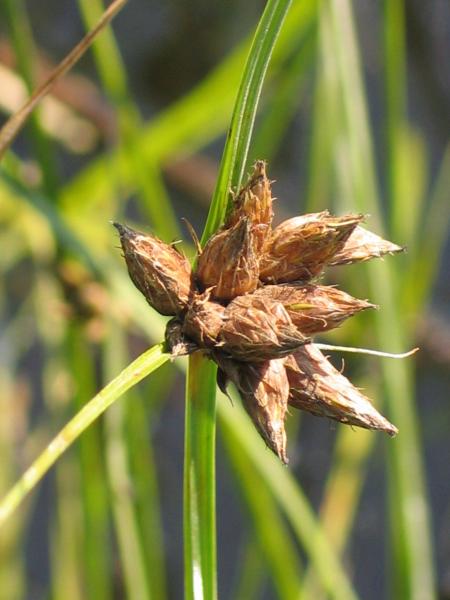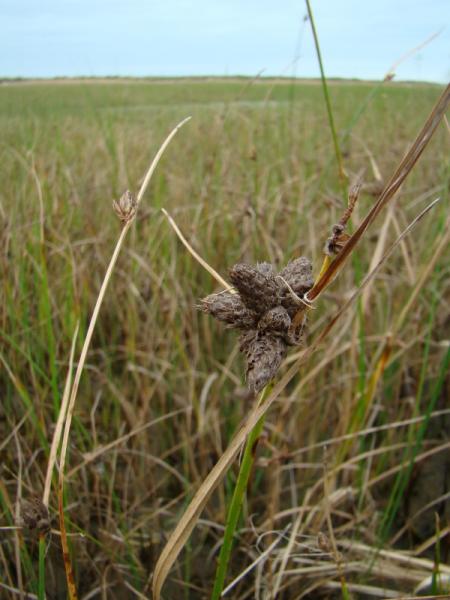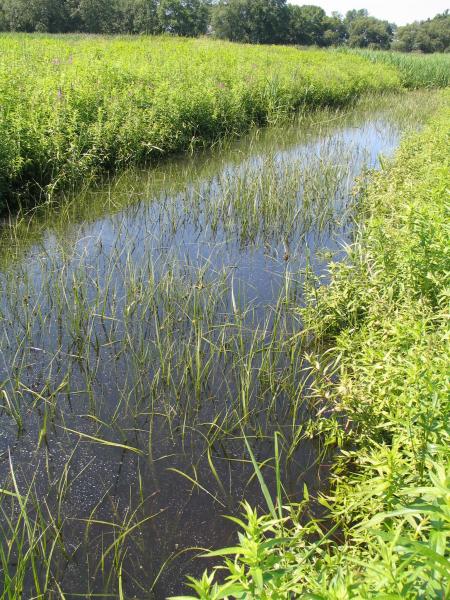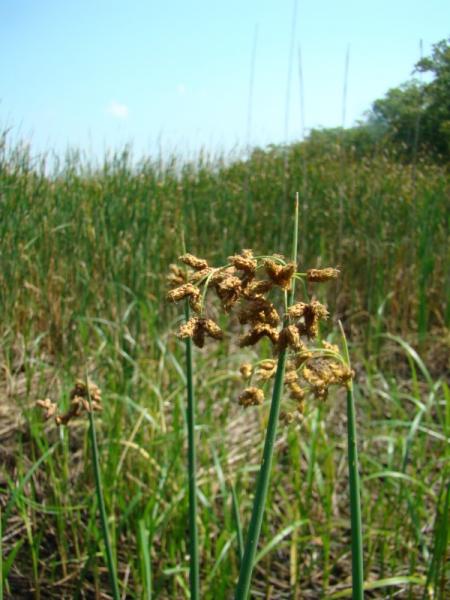American Saltmarsh Bulrush
Bolboschoenus maritimus ssp. paludosus (A. Nelson) T. Koyama
- Class
- Monocotyledoneae (Monocots)
- Family
- Cyperaceae (Sedge Family)
- State Protection
- Threatened
Listed as Threatened by New York State: likely to become Endangered in the foreseeable future. For animals, taking, importation, transportation, or possession is prohibited, except under license or permit. For plants, removal or damage without the consent of the landowner is prohibited.
- Federal Protection
- Not Listed
- State Conservation Status Rank
- S2
Imperiled in New York - Very vulnerable to disappearing from New York due to rarity or other factors; typically 6 to 20 populations or locations in New York, very few individuals, very restricted range, few remaining acres (or miles of stream), and/or steep declines.
- Global Conservation Status Rank
- G5T5
Secure globally - Both the species as a whole and the subspecies/variety are common in the world; widespread and abundant (but may be rare in some parts of its range).
Summary
Did you know?
The genus name is derived from the Greek "bolbo", a bulb, and "schoenus", a rush. It refers to the presence of corms in this genus. The Flora of North America treatment of the species states that it is likely that some populations of both subspecies are introduced from Europe (Flora of North America Editorial Committee 2002).
State Ranking Justification
There are 10 existing populations but half of them are small and threatened by Phragmites. There are 11 additional populations from the early 1900s that have not been resurveyed.
Short-term Trends
At least 3 populations have been reduced by the invasion of Phragmites and more are likely to be threatened.
Long-term Trends
This plan has always been rare in New York but populations were probably much larger in the past before the drainage and manipulation of wetlands and the introduction of Phragmites. Long-term future trends will be downward unless Phragmites can be controlled.
Conservation and Management
Threats
Many populations are threatened by the invasion of non-native Phragmites. Drainage and manipulation of coastal wetlands has reduced population numbers.
Conservation Strategies and Management Practices
Control Phragmites invasions in the salt marshes where it exists and prevent new incursions. Natural buffers should be established around the salt marshes to decrease pollution runoff and other direct human disturbances.
Research Needs
Besides Phragmites what may limit the expansion of populations in Long Island marshes.
Habitat
Habitat
In New York Seaside Bulrush has been found in a variety of open, saltwater or brackish wetlands, including disturbed sites such as roadsides and ditches (New York Natural Heritage Program 2010). Brackish to saline coastal and inland shores, marshes (FNA 2002).
Associated Ecological Communities
- Artificial pool
The aquatic community of a small pool that is constructed for recreational activities (e.g. swimming) or as a decorative element in a landscape design. The water is typically chlorinated, and flushed on a regular basis to reduce or eliminate the growth of algae, and bacteria; there is minimal development of any aquatic biota.
- Brackish interdunal swales
(guide)
Temporarily tidally flooded temperate marshes in interdunal swales dominated by salt-tolerant graminoids. Individual swales occur as small patches positioned between fore-, primary and secondary dunes in a maritime dunes system, typically on barrier islands.
- Brackish intertidal mudflats
(guide)
A sparsely vegetated community, characterized by low-growing, rosette-leaved aquatics. The community occurs on exposed intertidal mudflats where water salinity ranges from 0.5 to 18.0 ppt. This community is best developed where mudflats are nearly level so that broad expanses are exposed at low tide. The rosette-leaved aquatics are completely submerged at high tide, and they are usually coated with mud.
- Brackish intertidal shore*
A community of the intertidal gravelly or rocky shores of brackish tidal rivers and creeks where water salinity ranges from 0.5 to 18.0 ppt.
- Brackish meadow*
(guide)
A moist, moderately well-drained brackish (salinity 0.5-18 ppt) perennial grassland with occasional isolated shrubs that is typically situated in a belt at the upper edge of salt marshes bordering sandy uplands, but may occupy large portions of interdunal basins. The community usually develops in areas with a unique combination of soils and hydrology, on deep deposits of periodically windblown or overwashed gleyed sands that are usually flooded only during spring tides and during major coastal storms, approximately two to three times per year.
- Brackish tidal marsh*
(guide)
A marsh community that occurs where water salinity ranges from 0.5 to 18.0 ppt, and water is less than 2 m (6 ft) deep at high tide. The vegetation in a brackish tidal marsh is dense and dominated by tall grass-like plants.
- Coastal salt pond
(guide)
A community inhabiting marine shoreline lakes or ponds formed by sandspits that close off a lagoon or bay. The water typically averages brackish or slightly brackish over long periods of time, but may range rapidly from fresh to saline.
- Estuarine common reed marsh*
A tidal marsh dominated by non-native reedgrass (Phragmites australis). Estuarine reedgrass marshes may become established in tidal freshwater, brackish, and salt marsh settings. Establishment usually follows alteration of the original marsh through impacts such as dredging, ditching, or impounding water.
- Estuarine ditch
The aquatic community of a ditch or narrow channel excavated in an estuarine marsh for the intended purpose of reducing mosquito populations. These ditches have not been very effective in reducing mosquito populations; the ditches have probably done more harm to the salt marsh vegetation than is justified by the effectiveness of the mosquito control efforts.
- High salt marsh
(guide)
A coastal marsh community that occurs in sheltered areas of the seacoast, in a zone extending from mean high tide up to the limit of spring tides. It is periodically flooded by spring tides and flood tides. High salt marshes typically consist of a mosaic of patches that are mostly dominated by a single graminoid species.
* probable association but not confirmed.
Associated Species
- Agalinis
- Ageratina altissima
- Agrostis gigantea (red-top)
- Agrostis stolonifera (creeping bent)
- Ambrosia artemisiifolia (common ragweed)
- Anemone canadensis (Canada anemone)
- Apocynum cannabinum (Indian-hemp)
- Arctium
- Asclepias incarnata
- Asclepias syriaca (common milkweed)
- Asparagus officinalis (asparagus)
- Atriplex patula (spear orach)
- Baccharis halimifolia (groundsel-tree)
- Boehmeria cylindrica (false nettle)
- Bolboschoenus fluviatilis (river bulrush)
- Bolboschoenus robustus (sea-coast bulrush)
- Calamagrostis canadensis
- Calystegia sepium (hedge bindweed)
- Campanula aparinoides (marsh bellflower)
- Carex hormathodes (marsh straw sedge)
- Carex lasiocarpa
- Centaurium erythraea (common centaury)
- Cicuta maculata
- Cirsium arvense (creeping thistle, Canada thistle)
- Cirsium vulgare (bull thistle)
- Cornus racemosa (gray dogwood, red-panicled dogwood)
- Daucus carota (wild carrot)
- Dichanthelium acuminatum
- Drosera rotundifolia (round-leaved sundew)
- Elaeagnus umbellata (autumn-olive)
- Eleocharis parvula (salt-loving spike-rush)
- Elymus repens (quack grass)
- Equisetum arvense (field horsetail, common horsetail)
- Euthamia caroliniana (slender flat-topped-goldenrod)
- Euthamia graminifolia (common flat-topped-goldenrod)
- Eutrochium maculatum
- Fimbristylis autumnalis (autumn fimbry)
- Fraxinus pennsylvanica (green ash)
- Galium obtusum
- Helenium autumnale (common sneezeweed)
- Hibiscus moscheutos ssp. moscheutos (swamp rose-mallow)
- Hordeum jubatum
- Iris prismatica (slender blue iris, slender blue flag)
- Iris versicolor (blue flag)
- Juncus gerardii
- Juncus torreyi (Torrey's rush)
- Lathyrus palustris (marsh vetchling)
- Lythrum salicaria (purple loosestrife)
- Moehringia lateriflora (blunt-leaved-sandwort)
- Myrica pensylvanica
- Osmunda regalis
- Panicum virgatum (switch grass)
- Persicaria sagittata (arrow-leaved tear-thumb)
- Phalaris arundinacea (reed canary grass)
- Phragmites australis ssp. americanus
- Phragmites australis ssp. australis
- Plantago major (common plantain)
- Pluchea odorata (salt marsh-fleabane)
- Poa palustris (fowl blue grass)
- Prunus serotina
- Puccinellia distans (European alkali grass)
- Pycnanthemum muticum (short-toothed mountain-mint)
- Salix alba (white willow)
- Samolus valerandi (water pimpernel, brookweed)
- Schoenoplectus americanus (chair-maker's bulrush)
- Schoenoplectus pungens
- Schoenoplectus tabernaemontani (soft-stemmed bulrush)
- Scutellaria galericulata (marsh skull-cap)
- Sisyrinchium angustifolium (narrow-leaved blue-eyed-grass)
- Solanum dulcamara (bitter-sweet nightshade)
- Solidago altissima
- Solidago gigantea (swamp goldenrod)
- Sonchus arvensis
- Spartina pectinata (prairie cord grass)
- Spergularia maritima
- Spergularia salina
- Stachys palustris (marsh hedge-nettle)
- Stuckenia pectinata (Sago pondweed)
- Symphyotrichum lanceolatum
- Symphyotrichum puniceum
- Teucrium canadense (American germander)
- Thelypteris palustris
- Toxicodendron radicans
- Triadenum virginicum
- Typha angustifolia (narrow-leaved cat-tail)
- Urtica dioica ssp. gracilis
- Utricularia geminiscapa (hidden-fruited bladderwort)
- Verbena hastata (blue vervain)
- Viburnum dentatum var. venosum (southern arrowwood)
Range
New York State Distribution
This plant ranges from the salt marshes of Long Island to the inland salt ponds and marshes of the Finger Lakes.
Global Distribution
This plant ranges from coastal Nova Scotia and Quebec to New York in the Northeast then west and south from Michigan to Texas to the west coast and Alaska.
Identification Comments
General Description
Seaside Bulrush is a stout perennial graminoid (grass-like) plant, arising from tuberous rhizomes, with a triangular stem up to 1.5 m tall and 3 to 8 mm wide. The leaves sheath the stem for at least half its length, their widest blades are 2 to 12 mm wide. The infloresence consists of sessile spikelets, either solitary or in groups of 2-10, held on 1 to 4 rays up to 8 cm long, and overtopped by bracts up to 6 mm wide. The spikelets are covered with straw colored to orange-brown translucent pistillate scales. These cover brown achenes 2.3 to 4.1 mm long with beaks 0.1 to 0.4 mm long (FNA 2002).
Best Life Stage for Proper Identification
Seaside Bulrush best identified when in fruit.
Similar Species
Seaside Bulrush is the only species of Bolboschoenus in New York with all its spikelets sessile. B. robustus has at least some spikelets on evident branches, and has opaque, papery floral scales, differing from the hyaline, membranous floral scales of B. maritimus. Paludosus is the only subspecies of B. maritimus known from New York (FNA 2002).
Best Time to See
Seaside Bulrush flowers in August and the fruits can persist into October.
- Flowering
- Fruiting
The time of year you would expect to find American Saltmarsh Bulrush flowering and fruiting in New York.
American Saltmarsh Bulrush Images
Images of Similar Species
Taxonomy
American Saltmarsh Bulrush
Bolboschoenus maritimus ssp. paludosus (A. Nelson) T. Koyama
- Kingdom Plantae
- Phylum Anthophyta
- Class Monocotyledoneae
(Monocots)
- Order Cyperales
- Family Cyperaceae (Sedge Family)
- Order Cyperales
- Class Monocotyledoneae
(Monocots)
- Phylum Anthophyta
Additional Common Names
- Bayonet-grass
- Prairie Bulrush
- Salmarsh Bulrush
- Seaside Bulrush
Synonyms
- Scirpus maritimus L.
- Scirpus maritimus var. fernaldii (Bickn.)Beetle
- Scirpus maritimus var. paludosus (A. Nels.) Kukenth.
- Scirpus paludosus A. Nels.
- Scirpus paludosus var. atlanticus Fern.
Additional Resources
Best Identification Reference
Gleason, Henry A. and A. Cronquist. 1991. Manual of Vascular Plants of Northeastern United States and Adjacent Canada. The New York Botanical Garden, Bronx, New York. 910 pp.
Other References
Fernald, M. L. 1950. Gray's manual of botany. 8th edition. Corrected printing (1970). D. Van Nostrand Company, New York. 1632 pp.
Flora of North America Editorial Committee. 2002. Flora of North America, North of Mexico. Volume 23. Magnoliophyta: Commelinidae (in part): Cyperaceae. Oxford University Press, New York. 608 pp.
Holmgren, Noel. 1998. The Illustrated Companion to Gleason and Cronquist's Manual. Illustrations of the Vascular Plants of Northeastern United States and Adjacent Canada. The New York Botanical Garden, Bronx, New York.
Mitchell, Richard S. and Gordon C. Tucker. 1997. Revised Checklist of New York State Plants. Contributions to a Flora of New York State. Checklist IV. Bulletin No. 490. New York State Museum. Albany, NY. 400 pp.
New York Natural Heritage Program. 2010. Biotics database. New York Natural Heritage Program. New York State Department of Environmental Conservation. Albany, NY.
New York Natural Heritage Program. 2024. New York Natural Heritage Program Databases. Albany, NY.
Weldy, T. and D. Werier. 2010. New York flora atlas. [S.M. Landry, K.N. Campbell, and L.D. Mabe (original application development), Florida Center for Community Design and Research http://www.fccdr.usf.edu/. University of South Florida http://www.usf.edu/]. New York Flora Association http://newyork.plantatlas.usf.edu/, Albany, New York
Links
About This Guide
This guide was authored by: Stephen M. Young and Richard M. Ring
Information for this guide was last updated on: January 24, 2012
Please cite this page as:
New York Natural Heritage Program. 2024.
Online Conservation Guide for
Bolboschoenus maritimus ssp. paludosus.
Available from: https://guides.nynhp.org/seaside-bulrush/.
Accessed July 27, 2024.




